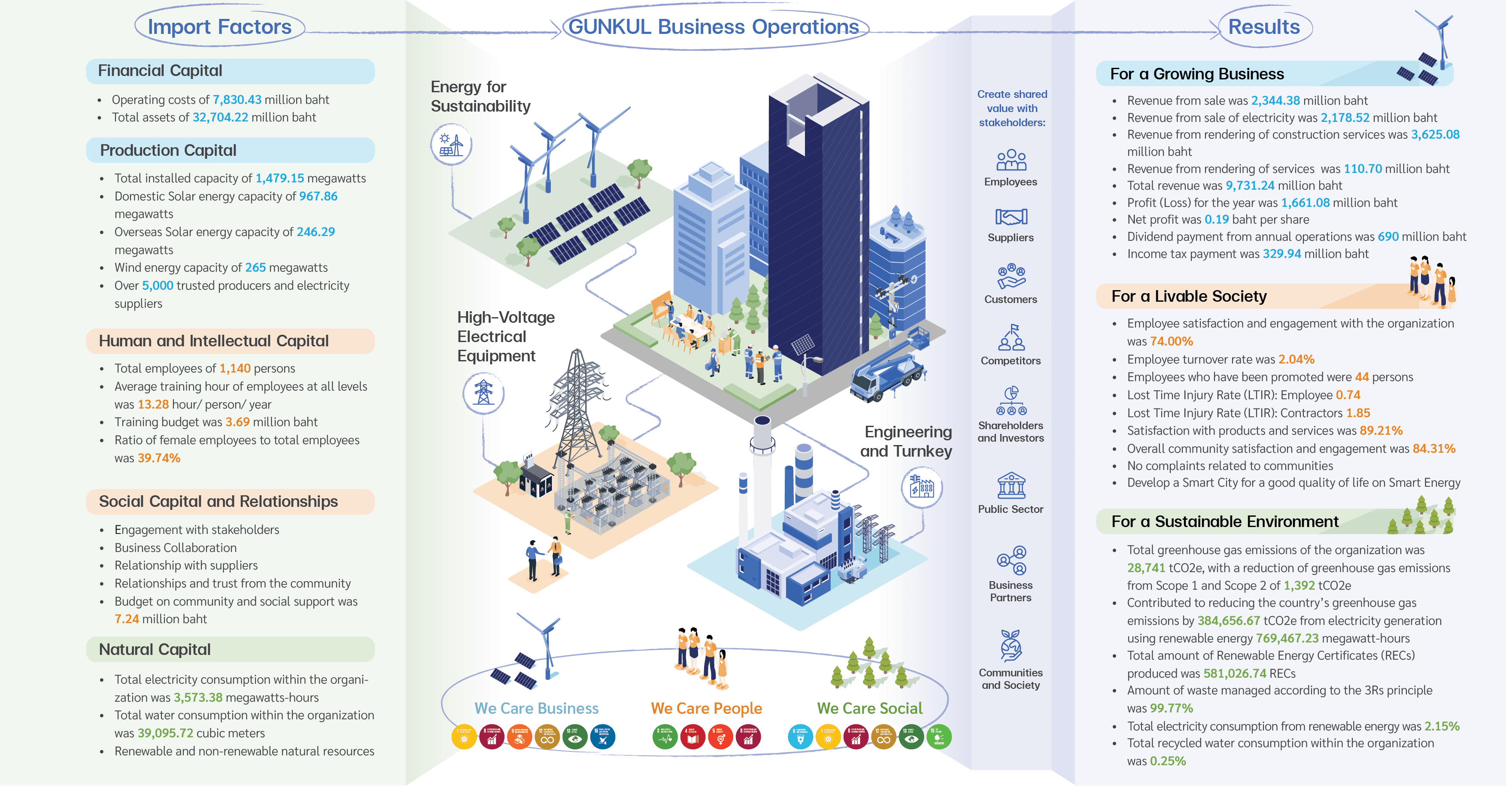Stakeholder Engagement
The Business Value Chain
The Company is committed to be integrated renewable energy, equipment and electrical system business operator, using modern technology and innovation to develop infrastructure that is strong and sustainable, enhancing the quality of life and good health by involving all stakeholders from upstream to downstream and importantly contribute to the long-term value of the Company. The Company analyzes the value chain from the activities of every business group to identify key stakeholders. This analysis leads to the assessment of expectations and the development of strategies to respond to those expectations, ensuring efficient business operations, minimizing potential risks, and fostering good relationships with stakeholders to grow together sustainably. The Company has identified 8 key stakeholder groups: employees, suppliers (products/ services providers, trade creditors), customers, competitors, shareholders and investors, public sector, business partners, and communities and society.
Input Factor
Results
For a Growing Business
Revenue from sale was
Revenue from sale of electricity was
Revenue from rendering of construction services was
Revenue from rendering of services was
Total revenue was
Profit (Loss) for the year was
Net profit was
Dividend payment from annual operations was
Income tax payment was
For a Livable Society
Employee satisfaction and engagement with the organization was
Employee turnover rate was
Employees who have been promoted were
Lost Time Injury Rate (LTIR): Employee
Lost Time Injury Rate (LTIR): Contractors
Satisfaction with products and services was
Overall community satisfaction and engagement was
Develop a Smart City for a good quality of life on
For a Sustainable Environment
Total greenhouse gas emissions of the organization was
with a reduction of greenhouse gas emissions from Scope 1 and Scope 2 of
Contributed to reducing the country’s greenhouse gas emissions by
Total amount of Renewable Energy Certificates (RECs) produced was
Amount of waste managed according to the 3Rs principle was
Total electricity consumption from renewable energy was
Total recycled water consumption within the organization was
Stakeholder Engagement
Expectations
- Good welfare and compensation that align with the current economic situation.
- Holistic welfare that cares for both physical and mental health to create a balance between life and work.
- Opportunities for learning and skill development, including new skills for career growth.
- Convenient work tools and a safe and pleasant working environment.
- The organization applies modern tools and technologies to improve work efficiency.
- Promoting learning that allows employees to engage with groups or interact in knowledge exchange with others (social learning).
- Transparency and good communication, listening to feedback, suggestions, and understanding employee needs.
- An organizational culture that promotes gender diversity and acceptance, with no discrimination against employees at any level.
Goals and Communication Channels
Goals :
- Employee satisfaction and organizational commitment rate of no less than 80%.
- Employee turnover rate is less than or equal to the previous year.
- Average employee training hours of no less than 9 hours per person per year.
- Employees have career progression and job stability.
- Work-related accident rate is zero.
Communication Channels :
- Employee survey to prepare suitable training courses for employees, aligned with business growth
- Employee satisfaction and organizational commitment survey
- Employee orientation program
- Activities to build employee engagement
- Executive meeting sessions with employees
- Dissemination of news and activities through internal communication channels
- 56-1 One Report and Sustainability Report
Responding to Key Expectations
Approaches to Responding :
- Conduct an annual market compensation survey to evaluate and develop policies for providing appropriate and flexible compensation, benefits, and welfare.
- Develop a recruitment system and employee selection process that is standardized, transparent, and fair for managing talent (Talent Management).
- Develop systems or standards for employee development to ensure their capabilities meet the company’s expectations, aligning the workforce with the organization’s growth.
- Create and provide training programs focused on developing skills relevant to employees in various job functions and levels, continuously making it a part of the organizational culture.
- Create spaces for knowledge exchange, experience sharing, and collaboration within the organization to enhance work efficiency and diversify skill development.
- Provide safe, suitable, and sufficient workspaces, equipment, and a conducive working environment.
- Develop internal tools or systems that meet the specific needs of the organization.
- Conduct an annual employee satisfaction and engagement survey.
- Create multiple, accessible communication channels and platforms for employee feedback.
- Foster a culture of acceptance of diversity and promote operations that respect human rights.
Performance Results Against Goals :
- Employee satisfaction and engagement with the organization: 74.00%
- Employee turnover rate: 2.04%, decreased from 2023 by 0.46%.
- Average employee training hours: 13.28 hours per person per year.
- Number of employees promoted: 44 people.
- Lost Time Injury Frequency Rate (LTIFR): Employee 0.74, Contractors 1.85
Expectations
- Transparent, fair, and auditable procurement practices.
- Awareness of current guidelines or policies related to the procurement system.
- Conducting business in compliance with laws, regulations, and contractual terms related to intellectual property rights.
- Building strong relationships with suppliers to promote effective collaboration.
- Listening to feedback and complaints from suppliers and stakeholders to improve and enhance operations.
- Protecting the information received from suppliers and ensuring it is not disclosed to unauthorized third parties.
- Collaborating in the development and enhancement of sustainable procurement practices.
Goals and Communication Channels
Goals :
- The performance evaluation score or suppliers’ performance assessment is at an excellent level.
- 100% of Critical suppliers with contracts have been communicated about the Supplier Code of Conduct.
- 100% of Critical suppliers have been assessed on sustainability, covering economic, social, and environmental (ESG) issues
Communication Channels :
- Supplier selection assessment
- Supplier risk assessment
- Supplier performance evaluation
- Business meetings or seminars
- Channels for receiving feedback, including complaints and suggestions
- 56-1 One Report and Sustainability Report
Responding to Key Expectations
Approaches to Responding :
- Develop a Supplier Code of Conduct and communicate it to suppliers through various channels.
- Establish criteria for selecting suppliers, considering sustainability factors.
- Review and improve the procurement process and collaboration strategies to achieve shared goals.
- Regularly evaluate key suppliers and assess their risks annually to develop supplier development plan.
- Implement controls and internal audit systems to ensure compliance with regulations and obligations related to intellectual property.
- Regularly visit suppliers to assess satisfaction, receive feedback or complaints, and improve processes.
- Comply with regulations and laws protecting personal data to ensure that suppliers information is safeguarded and kept confidential.
- Support the procurement of environmentally friendly products and services.
- Share knowledge on various topics to enhance the sustainability of suppliers.
Performance Results Against Goals :
- The performance evaluation score or suppliers’ performance assessment is at an excellent level.
- 100% of Critical suppliers have been communicated about the Supplier Code of Conduct.
- 100% of Critical suppliers have been assessed on sustainability, covering economic, social, and environmental (ESG) issues.
Expectations
- Products or services that are of high quality, safe, and meet standards.
- Delivery of products and services efficiently and quickly, fully meeting the terms or agreements.
- Products and services are reasonably priced and aligned with the current economic conditions.
- Effective after-sales support and services, providing prompt responses and assisting business partners in all situations.
- Offering innovative products or services, and developing modern technologies or processes to enhance competitive potential in the market.
- Compliance with relevant laws, especially concerning data security or other applicable regulations.
Goals and Communication Channels
Goals :
- Customer satisfaction with products and services of at least 90.00%.
Communication Channels :
- Channels for receiving feedback, including complaints and suggestions
- Customer satisfaction surveys
- Visits, meetings, training, and seminars
- Communication through social media platforms
- 56-1 One Report and Sustainability Report
Responding to Key Expectations
Approaches to Responding :
- Monitor and control the production process of goods and services to ensure compliance with international standards.
- Offer products or services that are of high quality, safe, and transparent with traceability.
- Plan product delivery and set clear delivery timelines, providing information from raw material sourcing to customer receipt.
- Develop a quality assurance system throughout the supply chain, from raw material sourcing to product delivery to customers.
- Set fair prices for goods and services while providing transparent information to customers.
- Train employees to enhance knowledge and expertise, ensuring efficient service that fully meets customer needs.
- Assess customer satisfaction to measure and improve product and service quality, ensuring better alignment with customer demands.
- Continuously develop renewable energy or clean technology innovations in the production of goods and services to benefit society and reduce environmental impact.
- Link research and product development with production processes to increase efficiency and improve product quality.
- Establish appropriate personal data protection measures (Personal Data Protection Act: PDPA) to safeguard personal data from unauthorized access.
Performance Results Against Goals :
- Customer satisfaction with products and services: 89.21%
Expectations
- Fair, transparent, and honest competition.
- Respecting and complying with copyright and intellectual property rights.
- Protecting business confidentiality and safeguarding sensitive information that may be valuable to stakeholders.
- Building collaboration for business growth.
Goals and Communication Channels
Goals :
- No complaints related to intellectual property or copyright infringement.
Communication Channels :
- Business seminars
- Meetings to discuss, exchange ideas, and collaborate on various agendas
- Company website
- 56-1 One Report and Sustainability Report
Responding to Key Expectations
Approaches to Responding :
- Operate with transparency, maintaining ethics and integrity in business competition.
- Define access levels for information, allowing only relevant and authorized individuals to access confidential data.
- Build partnerships and alliances within the same business sector to develop and expand the business sustainably.
Performance Results Against Goals :
- No complaints related to intellectual property or copyright infringement.
Expectations
- Good corporate governance and effective risk management.
- Strong performance, stable business growth, and profitability.
- Satisfactory and consistent returns (dividends).
- Successful business operations that meet objectives.
- Respect and fair treatment of all rights equally.
- Transparent, accurate, complete, and timely company information disclosure for decision-making.
Goals and Communication Channels
Goals :
- Investor relations survey results of at least 90.00%.
Communication Channels :
- Annual shareholders' meeting.
- Announcement of the business plan and the company's operational intentions, along with activities on "Opportunity Day"
- Analyst meetings
- Company website
- 56-1 One Report and Sustainability Report
Responding to Key Expectations
Approaches to Responding :
- Operate the business based on good corporate governance principles and follow the annual business plan.
- Achieve sustainable and balanced performance with effective risk management.
- Build trust and provide appropriate, maximum returns.
- Disclose business operations and results transparently, completely, and consistently.
- Participate in events organized by the Stock Exchange of Thailand, such as Opportunity Day, to regularly communicate business performance to investors.
Performance Results Against Goals :
- Investor relations survey results: 85.30%.
Expectations
- Compliance with relevant laws and regulations.
- Accurate and transparent reporting of operational results to the relevant government authorities.
- Promote good corporate governance based on business ethics.
- Opposition to bribery and corruption.
- Timely payment of taxes and fees.
- Cooperation and support for various government projects and activities.
Goals and Communication Channels
Goals :
- No cases of violation or non-compliance with government regulations.
- Participate in government projects and support government activities.
Communication Channels :
- Visits, meetings, training, and seminars
- Audits and standard reviews
- Organizing joint activities with the government
- 56-1 One Report and Sustainability Report
Responding to Key Expectations
Approaches to Responding :
- Operate the business under good governance practices and in compliance with relevant laws and regulations.
- Disclose information transparently and consistently.
- Participate in anti-corruption networks.
- Comply with tax laws and regulations.
- Cooperate with and support government projects and activities at the national level.
Performance Results Against Goals :
- No cases of violation or non-compliance with government regulations.
- Participated in the Human Rights Organization Project in 2024, Ministry of Justice, Rights and Liberties Protection Department.
Expectations
- Transparency in business operations.
- Strict compliance with safety, quality, environmental regulations, and other relevant laws.
- Effective risk management.
- Long-term planning, competitiveness, market expansion, and future investments.
- Creating added value and sustainable returns.
Goals and Communication Channels
Goals :
- No violations or non-compliance with agreements or contracts.
Communication Channels :
- Board meetings in subsidiaries and associated companies
- Company website
- 56-1 One Report and Sustainability Report
Responding to Key Expectations
Approaches to Responding :
- Operate under good governance practices and comply with relevant laws and regulations.
- Develop a comprehensive strategic plan for the renewable energy business.
- Invest in innovation to create new technologies that reduce production costs and improve energy efficiency.
- Develop projects with the potential to deliver high and sustainable returns, such as expanding the renewable energy market domestically and internationally, or investing in clean energy projects with strong financial returns.
- Develop a comprehensive risk management plan, covering financial, legal, and climate-related risks, such as investing in low-risk projects and using technologies that help mitigate the impact of natural disasters.
Performance Results Against Goals :
- No violations or non-compliance with agreements or contracts.
Expectations
- Promotion of stable employment, income, and improvement of quality of life.
- Active participation in community activities or projects that positively impact the social, economic, and environmental aspects of the community in a sustainable manner.
- Communication of information/plans in advance before implementing any activities in the community area.
- Support and allocate funds for community development.
- Provide valuable knowledge and open opportunities for skill development so that the community can access information related to renewable energy.
- Foster and build positive relationships with the community and society.
- Ensure good environmental care, without negative impact on the community.
Goals and Communication Channels
Goals :
- Achieve at least 80% community satisfaction with the Company’s operations.
- No complaints from society and the community.
- Reduce the organization’s greenhouse gas emissions compared to the previous year.
Communication Channels :
- Site visits and community meetings.
- Communication channels for receiving complaints, suggestions, and feedback.
Responding to Key Expectations
Approaches to Responding :
- Conduct site visits to listen to feedback, suggestions, and track the impacts on surrounding communities to improve the company’s operations plan.
- Allocate budgets for the maintenance and improvement of the community's infrastructure regularly.
- Apply environmentally friendly technologies and innovations to improve the community's quality of life sustainably.
- Continuously run renewable energy power plant learning center projects to develop the community's knowledge, especially in innovation and technology that can reduce dependence on fossil energy.
- Support various activities in collaboration with the community to meet their needs through beneficial activities that are suitable for the local context.
- Promote local employment and business creation to reduce unemployment and stimulate the local economy.
- Encourage the participation of all sectors of society to create a sustainable and healthy environment at the local and societal level.
- Foster a culture of environmentally friendly operations, reducing energy use and greenhouse gas emissions throughout the organization.
- Develop projects or activities to enhance the quality of life for the community, including vulnerable groups.
Performance Results Against Goals :
- Community satisfaction with the company’s operations: 84.31%
- No complaints from society and the community.
- Total greenhouse gas emissions of the organization of 3 scopes was 28,741 tCO2e, which total 3,189 tCO2e of scope 1 and scope, increased form 2023 by30.39%








